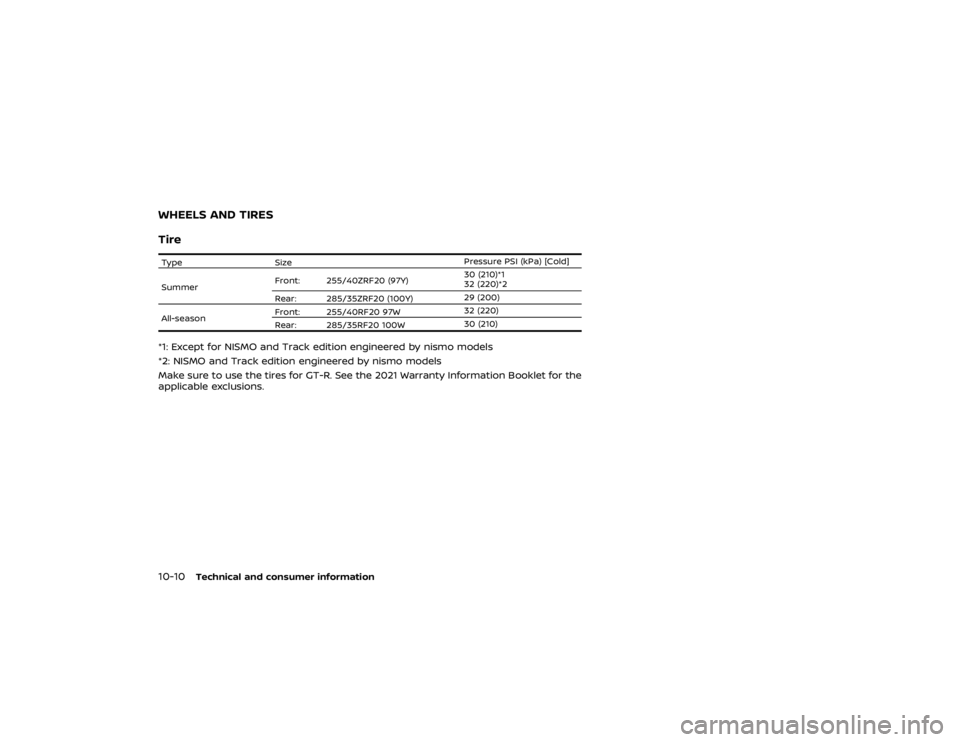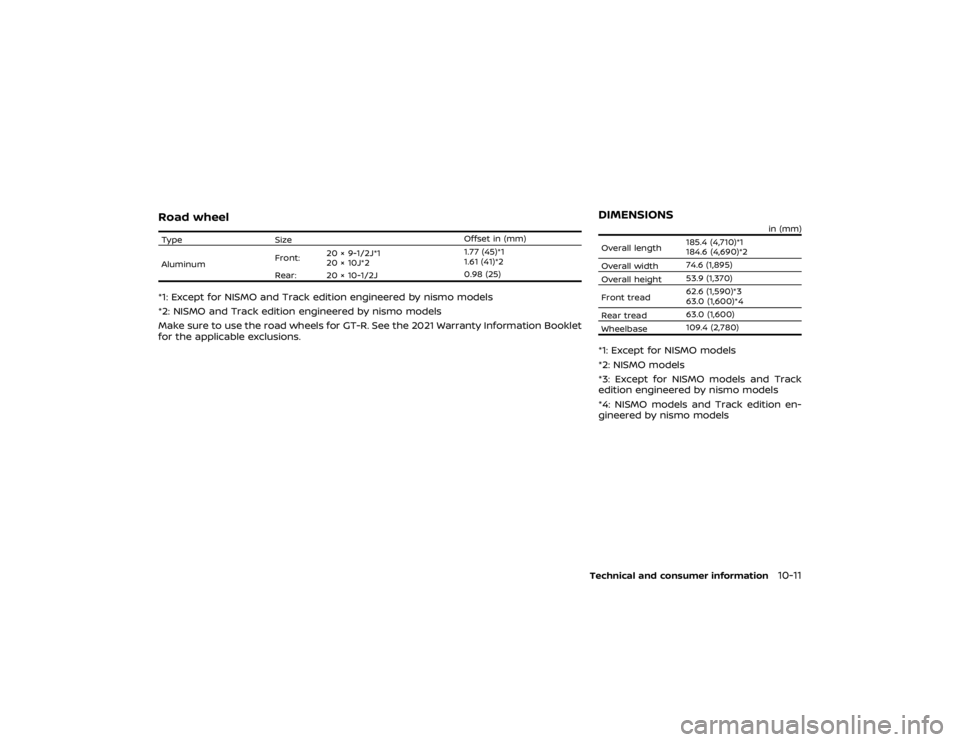NISSAN GT-R 2021 Owners Manual
Manufacturer: NISSAN, Model Year: 2021, Model line: GT-R, Model: NISSAN GT-R 2021Pages: 1808, PDF Size: 4.88 MB
Page 421 of 1808

NOTICE
Page 422 of 1808

Page 423 of 1808

Page 424 of 1808

is started.
If any malfunction occurs in the AWD
system while the engine is running, the
warning light will come on.
The warning light may blink rapidly
(about twice per second) while trying to
free a stuck vehicle due to high AWD
clutch temperature. The driving mode
may change to two-wheel drive. If the
warning light blinks rapidly during opera-
tion, stop the vehicle with the engine
idling in a safe place immediately. Then if
the light goes off after a while, you can
continue driving.
A large difference between the diameters
of front and rear wheels will make the
warning light blink slowly (about once per
two seconds). Pull off the road in a safe
area, and idle the engine. Check that all
tire sizes are the same, tire pressure is
correct and tires are not worn and winter
tires are not installed on the front or rear
wheels only.
If the warning light is blinking after the
above operation, it is recommended you
have your vehicle checked by a GT-R
certified NISSAN dealer as soon as possi-
ble.
If non-genuine GT-R tires are used, the
warning light may illuminate. (
Page 425 of 1808

TIGHT CORNER BRAKING PHE-
NOMENONIf the steering wheel is turned more than
half a turn when the vehicle is started
when it is cold, it may be harder to move
the vehicle forward and backward. This
phenomenon is known as the “tight
corner braking phenomenon”.
This phenomenon is unique to AWD
vehicles, and occurs due to a difference
in speeds between the front and rear
wheels while the vehicle is turning. This
does not indicate that there is a malfunc-
tion.
NOTE:
If the tight corner braking phenomenon
occurs, a slipping sound may be heard
from the tires, or a squeaking sound
may be heard from the drive system.Reducing tight corner braking
phenomenonThe tight corner braking phenomenon
can be reduced if the following three
conditions are met:
.Transmission setup switch is set to
Normal mode.
. Vehicle speed is low (less than ap-
proximately 6 MPH (10 km/h)). .
The steering wheel is turned more
than 1/2 turn.
TIRESThis vehicle is equipped with special tires.
When changing the tires, install the de-
signated special tires. Replacing tires as a
set of four with new ones is recom-
mended. However, if a tire is punctured
or damaged, it may be possible to replace
only the damaged tire. Determining
whether one tire or a complete set of
tires should be replaced is based on a
number of factors including tire wear and
condition. Contact your GT-R certified
NISSAN dealer. They can recommend if
an individual tire or a complete set should
be replaced.
NOTICE
If tires other than the designated
tires, tires with large differences in
wear or tires of different sizes are
installed, the AWD performance will
be degraded and the drive mechan-
ism may be damaged.
AWD SYSTEM CHARACTERISTICSThe AWD system automatically distri-
butes the optimal torque to the front
and rear wheels. This provides both the
superior turning performance of a rear
wheel drive vehicle and the traction of a
AWD vehicle.
Electronic control continuously distri-
butes torque to the front and rear wheels
in the range from 0:100 (rear-wheel drive
mode) to 50:50 (all-wheel drive mode) to
match the driving conditions and road
conditions. This allows the engine output
(torque) to be effectively transmitted to
the road surface.
Page 426 of 1808

Page 427 of 1808

position. Failure
to do so could cause the vehicle
to move unexpectedly or roll
away and result in an accident.
. Make sure the shift lever has
been pushed as far forward as it
can go and cannot be moved
without depressing the foot
brake pedal.
. Follow the instructions below
when parking the vehicle to help
prevent the brake rotor and
brake pads from rusting to-
gether. Failure to follow the in-
structions could cause the rotor
and pads to rust together. If the
rotor and pads rust together,
there may be a popping noise
and some vibration when the
vehicle is driven, a wheel may
not roll correctly, or the brake
pads could be damaged. If the
pads are damaged, this may re-
duce the effectiveness of the
brake system which could cause
a collision, serious personal injury
or death. (for models without
NCCB (NISSAN Carbon Ceramic
Brake) package)
PARKING/PARKING ON HILLS
Page 428 of 1808

position.
3. To help prevent the vehicle from roll- ing into the street when parked on a
sloping drive way, it is a good practice
to turn the wheels as illustrated.
.
HEADED DOWNHILL WITH CURB:Turn the wheels into the curb and
move the vehicle forward until the
curb side wheel gently touches the
curb.
.
HEADED UPHILL WITH CURB:Turn the wheels away from the
curb and move the vehicle back
until the curb side wheel gently
touches the curb.
.
HEADED UPHILL OR DOWNHILL, NO
CURB:Turn the wheels toward the side of
the road so the vehicle will move
away from the center of the road if
it moves.
4. Push the ignition switch to the LOCK position.
For models without NCCB (NISSAN Car-
bon Ceramic Brake) package:
The GT-R uses brake pad materials that
have high metallic content. The brake pad
material helps maintain braking perfor-
mance in a wide range of weather and driving conditions.
For the first 3,000 - 6,000 miles (5,000 -
10,000 km) of the vehicle’s service life, and
for the first 3,000 - 6,000 miles (5,000 -
10,000 km) after a brake replacement, the
brake pad to brake rotor clearance is very
small. When parking, apply the parking
brake and move the shift lever to the
position. Idle the engine for more than 20
seconds without depressing the brake
pedal. This allows the brake pads to move
away from the rotor so the pad does not
contact the rotor.
Additionally, the brakes must be dry
before parking the vehicle after driving
on wet roads or after washing the vehicle.
If the roads are wet, lightly apply the
brakes for a short distance before parking
the vehicle to dry the brakes. After wash-
ing the vehicle, dry the brakes by driving
on a dry road for a few miles and apply
the brakes normally based on traffic and
road conditions.
The metallic brake pads and brake disc
rotor may rust together when the brakes
are not applied:
.
If the vehicle is not idled for 20
seconds without the brakes applied,
or if the brakes are applied when the
vehicle is shut off, the rotor and pads
can rust together, even when the brake pads are dry.
. If the brakes are wet when the vehicle
is parked and the parking brake is
applied for a long time.
It is recommended you contact a GT-R
certified NISSAN dealer if the brake pads
and brake rotor have rusted together.
For models with NCCB (NISSAN Carbon
Ceramic Brake) package:
(
“NCCB (NISSAN Carbon Ceramic
Brake)” page 8-20)
Starting and driving
5-47
Page 429 of 1808

CAUTION
.Keep the interior of the vehicle as
quiet as possible to hear the tone
clearly. Excessive noise (such as
audio system volume or an open
vehicle window) will interfere
with the tone and it may not be
heard.
. Keep the sonar (located on the
bumper fascia) free from snow,
ice and large accumulations of
dirt (do not clean the sonar with
sharp objects). If the sonar is
covered, it will affect the accuracy
of the sonar system.
. The sonar system may not oper-
ate correctly if a license plate
cover is installed.
The sonar system sounds a tone to warn
the driver of obstacles near the bumper.
The sonar indicator will also appear in the
touch screen display. (
“Sonar indica-
tor” page 5-49.) The system detects front
obstacles when the shift lever is in the
position or
position and both front and
SONAR SYSTEM
Page 430 of 1808

position.
The system may not detect objects at
speeds above 6 MPH (10 km/h) and may
not detect certain angular or moving
objects.
Refer to the illustration for approximate
zone coverage areas. As you move closer
to the obstacle, the rate of the tone
increases. When you move even closer
to the obstacle, the tone will sound
continuously.
The sensitivity level of the sonar can be
adjusted (higher or lower) in the sonar
setting display. (